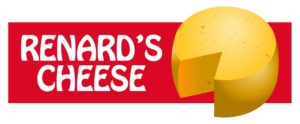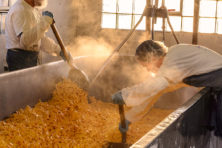Renard’s Plans Major Production Expansion
- Share
- Tweet
- Pin
- Share

Project to benefit farmers, workers
Construction of a 50,000-square-foot facility will help triple production of Renard’s cheese while also decreasing the physical demands on workers.
Renard’s, referred to by the state as Rosewood Dairy, makes cheese in a century-old, 4,500-square-foot building that’s rather cramped inside.
“We’ve upgraded it to the point that we can,” said company president Ann Renard. “We’ve been turning down about 4-6 million pounds of production annually.”
Expansion – to start in fall 2024 and take up to 24 months – will meet demand from farms in the area while expanding production from 3 to 12 million pounds per year.
“We have a waiting list of smaller farms – greater than 40 – that would like to ship their milk to us,” Ann Renard said. “We have the opportunity to have the milk supply, and we have the opportunity to make cheese for customers that want it.”

Master Cheesemaker Chris Renard said construction of the new facility with expanded warehousing and cut-and-wrap packaging capacity will come as the third of three phases of expansion of Renard’s retail location and Rosewood Dairy cheese plant on County Road S in the town of Clay Banks. Renard applied for two grants to help pay a fraction of costs for the 50,000-square-foot facility.
“We’re still making things in open vats and handcrafted,” Ann Renard said. “The only difference after phase III is complete, we’ll be able to do it in one building under one roof and we’ll have a lot of equipment that will help our employees so it’s not so physical.”
The company currently employs 88 people, having added 25 employees in the past year, she said. After expansion, Renard’s/Rosewood Dairy can add 25 more employees.
Chris Renard said the new facility will have six cheese-making vats that will increase efficiency. The existing four vats must be drained of whey before cheese can be flattened into mats and milled into curds.

The new facility will have a system to move the cheese from three deeper vats into three shallower “matting vats,” making the cheese vats available more quickly and reducing strain on workers.
Right now, said Chris, workers lean outward and downward to knee level and fill buckets with about 30 pounds of cheese – over and over until the 1,500-pound-capacity vat is empty and cheese-wheel forms are filled. Workers rotate from job to job to avoid having the same motions day after day, he said.
“With the new facility and the new equipment, they’ll be working at their waist level, which is a big improvement,” Ann said.

Two Other Projects and Two Grants
This spring, Renard’s will complete additions to its food-prep area and cooler and freezer capacity and expand the parking area at its retail facility at 2189 County Road DK. Also, the business expanded its water-storage capacity at its production facility on County Road S.
Workers spend about one third of each day cleaning vats and equipment. Water from the cleaning is pumped into the new water-storage facility.
The company has permits to spray its wastewater – or wash-water – on farm fields. Before constructing the storage tank, the dairy had to haul water every day and apply it back to farm fields.
“Now we can store up to six months, which is really nice,” Ann Renard said. “When it’s raining and the ground is saturated, we don’t want to be applying water. Now when the fields are dry and they need the water, we can apply. A lot of farmers like to have water applied back to the fields after hay-cutting.”
In February, the company received a $29,366 Department of Agriculture, Trade and Consumer Protection Dairy Processor grant for design plans for a wastewater loadout building and office relocation.
The dairy in May 2023 also received a $100,000 grant from Dairy Business Innovation Alliance to install a trial vat.
“This allows us to make trial batches in 250-pound increments vs. 1500-pound increments,” Ann Renard said. “With most recipes requiring at least four and at times up to 12 batches, to fine-tune flavor, texture and desired results by the customer, this is a significant advantage to our company and the customer. We can accomplish more with less.”




